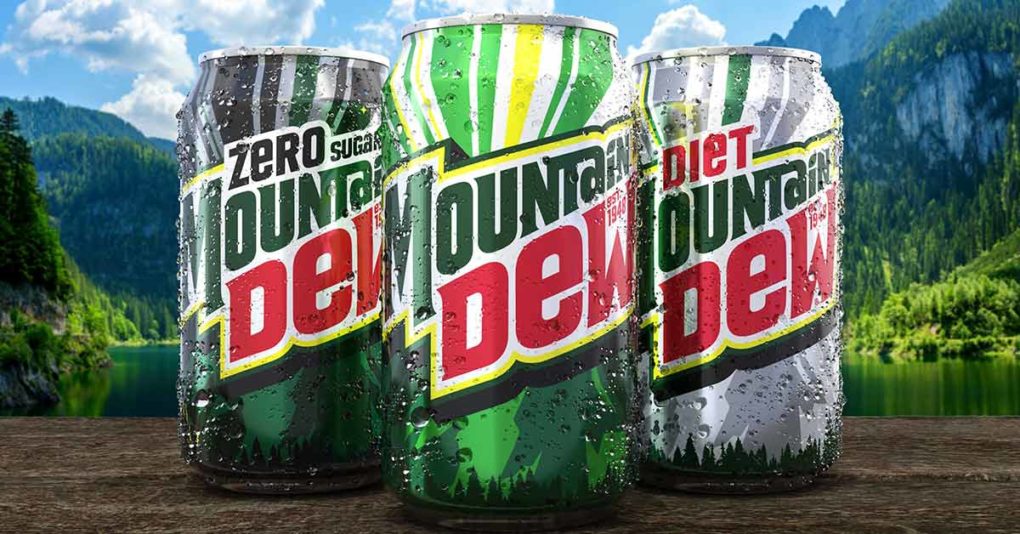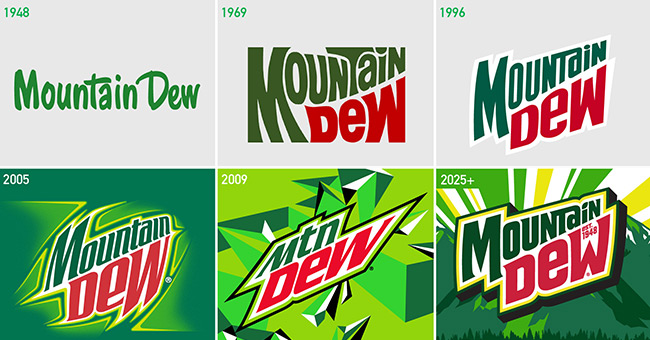To capture the attention of a broader audience with something new, PepsiCo-owned soda brand Mountain Dew is, in part, betting on something old.
The 76-year-old brand today unveiled a refreshed visual identity that leans into its origins in the foothills of the Tennessee mountains while placing a new emphasis on “energizing refreshment” and togetherness. The refresh spans all elements of Mountain Dew (formerly stylized as MTN DEW since 2009) branding – from its logo to its color scheme to its label callouts – to “have something more accessible for a broader audience” and “start giving folks a moment to reconsider the brand,” according to JP Bittencourt, VP of marketing at Mountain Dew.
The new cans and bottles, set to roll out next summer, harken back to Mountain Dew’s roots with the incorporation of 1948, the year the brand was established. Additionally, the brand is returning to its origins by again spelling out the word “Mountain,” complete with an emblematic citrus leaf dotting the “i.”
A refreshed color palette illustrates the brand’s passion for the outdoors, including a new bright yellow that, according to the brand, “nods to the soda’s citrus flavor to complement the energetic greens and reds.” Each flavor features a unique outdoor landscape that will serve as a canvas for innovation and storytelling about the brand’s roots.
“[With] old brands, you have to give a lot of care and nurture to them because both brands and consumers change and consumers change,” said Bittencourt. “We’re positioning Mountain Dew less away from a singular, individualistic orientation and into something more.”
He continued, “We wanted to ensure that we were getting the refreshment taste credentials that we love while also having something that was a bit more accessible for a broader audience.”
Launched by Tennessee beverage bottlers Barney and Ally Hartman, Mountain Dew was originally formulated as a mixer for moonshine. PepsiCo acquired the brand in 1964 when it purchased the Tip Corporation, which owned Mountain Dew and its production rights, and has since become a $9 billion global brand.
The soda brand has rotated through multiple visual identities throughout the years, most recently in 2009. At that time, Mountain Dew, like many beverage brands, adopted a modern look with neon colors that it now recognizes “probably [strayed] too far away from its origin, legacy and authenticity.”
But a brand can’t complete a redesign every year. And so, over the past 15 years, PepsiCo doubled down on research, including both internal and external communications with consumers that helped inform its latest look.
Mountain Dew isn’t the only PepsiCo brand betting on nostalgia to grow its consumer base. Last year, sister brand Pepsi debuted a new logo that “pays homage to the brand’s rich heritage while taking a big leap toward the future.”
According to a recent report by Mintel, nostalgia marketing is on the rise as food and beverage consumers continue to seek out products and experiences that capture the feeling of familiarity and safety of the past, especially in times of conflict and uncertainty. The sentimental longing for the good times of an idealized past is a strong selling point.
“Throwback nostalgia no longer belongs to just those who have had a particular experience, but also consumers who are looking to have throwback experiences that existed for others. Interacting with the retro can help consumers create their own memories in the setting of another age,” the report reads.
Mountain Dew’s new visual identity builds on its latest marketing efforts, including its revamped DO THE DEW campaign and the introduction of “The Mountain Dude,” a long-haired, fur coat-clad mountain man who encourages consumers to get off their a** and head outdoors.
Looking ahead, PepsiCo believes the refreshed Mountain Dew brand will continue to be a growth pillar in 2025 and beyond.
“The right move was to go back to something that was more authentic and anchored in the history of the brand while projecting it into the future. This is the balance that we always look for,” said Mauro Porcini, SVP and chief design officer at PepsiCo.

